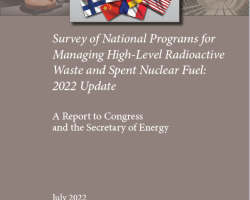Category of Content
Siting Experience Documents Only
Publication Date
Subject Matter
FY 2013 Summary Report:? Post-Irradiation Examination of Zircaloy-4 Samples in Target Capsules and Initiation of Bending Fatigue Testing for Used Nuclear Fuel Vibration Integrity Investigations
FY 2013 Summary Report:? Post-Irradiation Examination of Zircaloy-4 Samples in Target Capsules and Initiation of Bending Fatigue Testing for Used Nuclear Fuel Vibration Integrity Investigations
Embrittlement and DBTT of HighBurnup PWR Fuel Cladding Alloys
Embrittlement and DBTT of HighBurnup PWR Fuel Cladding Alloys
Results of Ring Compression Tests
Results of Ring Compression Tests
Modeling and Analysis to Support Spent Nuclear Fuel Drop Tests
Modeling and Analysis to Support Spent Nuclear Fuel Drop Tests
Modeling and Analysis for Spent Nuclear Fuel Seismic Testing
Modeling and Analysis for Spent Nuclear Fuel Seismic Testing
Used Fuel Disposition Campaign Phase I Ring Compression Testing of High-Burnup Cladding
Used Fuel Disposition Campaign Phase I Ring Compression Testing of High-Burnup Cladding
Interim Storage, Environmental Justice, and Generational Equity
Interim Storage, Environmental Justice, and Generational Equity
With the termination of the Yucca Mountain project, which was proposed to be our nation’s first repository for the disposal of military and civilian spent nuclear fuel and high-level radioactive waste, the future of nuclear waste management and disposal in this country became increasingly uncertain. Interim storage has been advocated by many as a temporary solution while a permanent solution is studied for potentially several more decades to come.
Survey of National Programs for Managing High-Level Radioactive Waste and Spent Nuclear Fuel: 2022 Update
Survey of National Programs for Managing High-Level Radioactive Waste and Spent Nuclear Fuel: 2022 Update
In October 2009, the U.S. Nuclear Waste Technical Review Board (Board or NWTRB) published Survey of National Programs for Managing High-Level Radioactive Waste and Spent Nuclear Fuel. For each of the 13 national programs studied, the report catalogued 15 institutional arrangements that had been set in place and 15 technical approaches that had been taken to design repository systems for the long-term management of high-activity radioactive waste.

